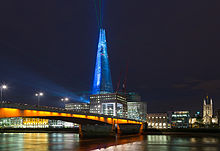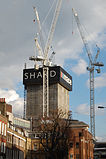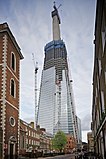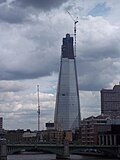The Shard (also referred to as Shard London Bridge, the London Bridge Tower[3][4] or the Shard of Glass[5][6]) is a skyscraper in London, England. Standing 309.6 metres (1,016 ft) high, it was topped out on 30 March 2012[7] and opened on 5 July 2012. The Shard is the tallest building in Europe, and is also the second-tallest free-standing structure in the United Kingdom, after the 330-metre (1,083 ft) concrete tower at the Emley Moor transmitting station.
The Shard replaced Southwark Towers, a 24-story office block built on the site in Southwark in 1975. Renzo Piano, the Shard's architect, worked with the architectural firm Broadway Malyan during the planning stage. The tower has 72 habitable floors, with a viewing gallery and open-air observation deck – the UK's highest – on the 72nd floor, at a height of 245 metres (804 ft).[8] The Shard was designed with an irregular pyramidal shape from the base to the top, and is clad entirely in glass. Its structure was completed in April 2012. The tower is scheduled to open to the public in February 2013.[9][10]
In July 2002, then-Deputy Prime Minister, John Prescott, ordered a planning inquiry after the Shard development plans were opposed by local authorities and heritage bodies, including the Royal Parks Foundation and English Heritage.[13][14] The inquiry took place in April and May 2003,[15][16] and on 19 November 2003, the Office of the Deputy Prime Minister announced that construction had been approved.[17] The government released a letter stating that:
 The developers – CLS Holdings plc, Sellar Property Group, and CN Ltd (acting for the Halabi Family Trust) – secured an interim funding package of £196 million in September 2006 from the Nationwide Building Society and Kaupthing Singer & Friedlander. This enabled them to pay off the costs already incurred and to buy out the Southwark Towers occupational lease from the tenants, PricewaterhouseCoopers.[18] Vacant possession of the site was secured a year later, after PricewaterhouseCoopers completed the relocation of their operations.
The developers – CLS Holdings plc, Sellar Property Group, and CN Ltd (acting for the Halabi Family Trust) – secured an interim funding package of £196 million in September 2006 from the Nationwide Building Society and Kaupthing Singer & Friedlander. This enabled them to pay off the costs already incurred and to buy out the Southwark Towers occupational lease from the tenants, PricewaterhouseCoopers.[18] Vacant possession of the site was secured a year later, after PricewaterhouseCoopers completed the relocation of their operations.
In September 2007, preparations for the demolition of Southwark Towers began.[19] However, later in the month, turbulence in the financial markets reportedly put the construction phase of the project in jeopardy,[20] threatening to render the whole project an example of the Skyscraper Index. Later that month, it was reported that the Halabi Family Trust, one of the main backers of the project, had been forced to sell its stake.[21]
In November 2007, building contractor Mace was awarded the contract to build the Shard for a fixed price of no more than £350 million. However, this price increased to almost £435 million in October 2008.[22]
In April 2008, demolition of Southwark Towers was visibly under way, with scaffolding and white sheeting covering the building,[23] and by October, Southwark Towers had been substantially reduced in height, and was no longer visible on the skyline. The building's demolition was completed in early 2009, and site preparation began for the construction of the Shard.
Since the Shard's construction was financed by Sharia-compliant investment, which forbids earning money through interest payments, the tower's tenants are subject to certain conditions. For example, most banks and companies connected to either the gambling or alcohol industries are unlikely to receive permission to lease space in a building which is backed by Islamic finance.[25]
According to one of the tower's developers, the Shard and its neighbouring building, the Place, may together be worth up to £2.5 billion when they are fully leased.[26]
Following the destruction of the World Trade Center (WTC) in September 2001, architects and structural engineers worldwide began re-evaluating the design of tall structures. The Shard’s early conceptual designs were among the first in the UK to be progressed following the publication of the US National Institute of Standards and Technology (NIST) report into the WTC collapse. The building was designed to maintain its stability under very onerous conditions.[29]
The Shard contains premium office space, a hotel, luxury residences, retail space, restaurants, a five-storey public viewing gallery, and a spa.[30] The public viewing gallery is located on the 72nd floor, at a height of 245 metres (804 ft), and is expected to draw over two million visitors a year once it opens in February 2013. The gallery's adult entry fee will be £24.95 (US$39.02).[31] In addition, a shorter building, known as London Bridge Place, will be built nearby. This will replace the former London Bridge House, and the combined sites will create what will be known as the London Bridge Quarter.
In addition to the tower, there will be major improvements made to the London Bridge rail and Tube station and the surrounding area. As part of a Section 106 legal agreement, these improvements will include a new public concourse, as well as a public piazza, a museum, and local housing and regeneration programmes.[32] In May 2012, the Shard's developers pledged to offer 300 jobs in the tower and its environs for unemployed locals.[33]
Source: Shard London Bridge brochure, 2010
Five cranes were used to build the Shard, with four of them 'jumping' with the tower as it rose. Crane 1 was erected on 20 September 2009 and Crane 2 was erected at the beginning of October. By 20 October 2009, steel beams began appearing on site, with concrete being poured at the northern part of the site, ready for Crane 3.
By mid-November 2010, the third core had reached the 68th floor (rising approximately 235 metres), with the tower's steel reaching the 40th floor and cladding enveloping a third of the building. In late November, it passed the 235-metre (771 ft) mark, ending One Canada Square's 18-year reign as Britain's tallest building.[40]
August 2011 saw steady progress in construction, with cladding enveloping more than half the building's exterior. Pouring of the concrete floors reached the 67th floor, and progression on the tower's cladding reached the 58th floor. By mid-August, the core box had been removed. By 19 September 2011, the tower's steel was approaching the height of the completed core, reaching almost 244 metres (801 ft).[41] On 24 September, a final crane – the tallest ever built in Britain – was erected to install the skyscraper's upper spire.[42] The spire was pre-fabricated and pre-assembled based upon 3D models, and underwent a "test run" in Yorkshire before being lifted onto the building itself.[43] By late December 2011, the Shard had become the tallest building in the European Union, superseding the Commerzbank Tower in Frankfurt, Germany.[10]
In December 2011, trespassers, the self-styled Place Hackers, evaded security and made their way to the top of the Shard building site, climbing one of the tallest cranes in the process.[44] They later posted photographs of the London skyline taken from the top of the Shard on the Internet.
In April 2012, it was revealed numerous teams of "urban explorers" had climbed the building. Others had BASE jumped from the Shard more than a dozen times in the previous three years. Four jumps were reportedly made by Essex roofer Dan Witchalls, who had filmed one attempt with a helmet-mounted camera. The highest jump was said to have been from a height of 850 feet (260 m).[48]
The Shard was formally opened on 5 July 2012 by the Prime Minister of Qatar, Hamad bin Jassim bin Jaber Al Thani, in a ceremony attended by Prince Andrew, Duke of York.[49] The opening ceremony featured a large laser light show, comprising twelve lasers and 30 searchlights, which illuminated the building on the London skyline.[50] The Shard was opened with all its office floors unlet.[51]
Another London skyscraper, the Bishopsgate Tower, was originally proposed to rival the height of the Shard. However, because of concerns from the Civil Aviation Authority, the height of the Bishopsgate Tower was later reduced to 288 metres (945 ft).[55]
The Shard replaced Southwark Towers, a 24-story office block built on the site in Southwark in 1975. Renzo Piano, the Shard's architect, worked with the architectural firm Broadway Malyan during the planning stage. The tower has 72 habitable floors, with a viewing gallery and open-air observation deck – the UK's highest – on the 72nd floor, at a height of 245 metres (804 ft).[8] The Shard was designed with an irregular pyramidal shape from the base to the top, and is clad entirely in glass. Its structure was completed in April 2012. The tower is scheduled to open to the public in February 2013.[9][10]
Background
[edit] Planning
The Shard was designed in 2000 by Renzo Piano, an Italian architect best known for creating Paris’s Pompidou Centre in collaboration with Britain’s Richard Rogers. That year, the London-based entrepreneur Irvine Sellar decided to redevelop Southwark Towers, a 1970s office block next to London Bridge station, and flew to Berlin in March 2000 to meet Piano for lunch. According to Sellar, the architect spoke of his contempt for tall buildings during the meal, before flipping over the restaurant’s menu and sketching an iceberg-like sculpture emerging from the River Thames.[11] He was inspired by the railway lines next to the site, the London spires depicted by the 18th-century Venetian painter Canaletto, and the masts of sailing ships.[12]In July 2002, then-Deputy Prime Minister, John Prescott, ordered a planning inquiry after the Shard development plans were opposed by local authorities and heritage bodies, including the Royal Parks Foundation and English Heritage.[13][14] The inquiry took place in April and May 2003,[15][16] and on 19 November 2003, the Office of the Deputy Prime Minister announced that construction had been approved.[17] The government released a letter stating that:
"Mr Prescott would only approve skyscrapers of exceptional design. For a building of this size to be acceptable, the quality of its design is critical. He is satisfied that the proposed tower is of the highest architectural quality."

The Southwark Towers office block, which was demolished to make way for the Shard
In September 2007, preparations for the demolition of Southwark Towers began.[19] However, later in the month, turbulence in the financial markets reportedly put the construction phase of the project in jeopardy,[20] threatening to render the whole project an example of the Skyscraper Index. Later that month, it was reported that the Halabi Family Trust, one of the main backers of the project, had been forced to sell its stake.[21]
In November 2007, building contractor Mace was awarded the contract to build the Shard for a fixed price of no more than £350 million. However, this price increased to almost £435 million in October 2008.[22]
In April 2008, demolition of Southwark Towers was visibly under way, with scaffolding and white sheeting covering the building,[23] and by October, Southwark Towers had been substantially reduced in height, and was no longer visible on the skyline. The building's demolition was completed in early 2009, and site preparation began for the construction of the Shard.
[edit] Funding
In late 2007, the gathering uncertainty in the global financial markets sparked concerns about getting the Shard's construction started. The project was almost cancelled, but in January 2008, it was announced that a consortium of Qatari investors had paid £150 million to secure an 80% stake and take control of the project. The new owners promised to provide the first tranche of finance, allowing construction of the tower to begin. The consortium included Qatar National Bank, QInvest, Qatari Islamic Bank and the Qatari developer Barwa Real Estate. The deal involved a buyout of the Halabi and CLS Holdings stakes, and part of the Sellar Property stake.[24]Since the Shard's construction was financed by Sharia-compliant investment, which forbids earning money through interest payments, the tower's tenants are subject to certain conditions. For example, most banks and companies connected to either the gambling or alcohol industries are unlikely to receive permission to lease space in a building which is backed by Islamic finance.[25]
According to one of the tower's developers, the Shard and its neighbouring building, the Place, may together be worth up to £2.5 billion when they are fully leased.[26]
[edit] Architecture
Renzo Piano, the project's architect, met criticism from English Heritage, who claimed the building would be 'A shard of glass through the heart of historic London', giving the building its current name 'The Shard'.[27] He considered the slender, spire-like form of the tower a positive addition to the London skyline, recalling the church steeples featured in historic engravings of the city, and believed that its presence would be far more delicate than opponents of the project alleged. He proposed a sophisticated use of glazing, with expressive façades of angled glass panes intended to reflect sunlight and the sky above, so that the appearance of the building will change according to the weather and seasons.[28] The building features 11,000 panes of glass.Following the destruction of the World Trade Center (WTC) in September 2001, architects and structural engineers worldwide began re-evaluating the design of tall structures. The Shard’s early conceptual designs were among the first in the UK to be progressed following the publication of the US National Institute of Standards and Technology (NIST) report into the WTC collapse. The building was designed to maintain its stability under very onerous conditions.[29]
The Shard contains premium office space, a hotel, luxury residences, retail space, restaurants, a five-storey public viewing gallery, and a spa.[30] The public viewing gallery is located on the 72nd floor, at a height of 245 metres (804 ft), and is expected to draw over two million visitors a year once it opens in February 2013. The gallery's adult entry fee will be £24.95 (US$39.02).[31] In addition, a shorter building, known as London Bridge Place, will be built nearby. This will replace the former London Bridge House, and the combined sites will create what will be known as the London Bridge Quarter.
In addition to the tower, there will be major improvements made to the London Bridge rail and Tube station and the surrounding area. As part of a Section 106 legal agreement, these improvements will include a new public concourse, as well as a public piazza, a museum, and local housing and regeneration programmes.[32] In May 2012, the Shard's developers pledged to offer 300 jobs in the tower and its environs for unemployed locals.[33]
[edit] Power supply
The Shard was designed with energy efficiency in mind. It is fitted with a combined heat and power (CHP) plant, operating on natural gas. The gas engine is fuelled by gas originating from the National Grid. Fuel is efficiently converted to electricity and heat is recovered from the engine to provide hot water for the building.[34][edit] Layout
| Floors | Floor area | Space designation |
|---|---|---|
| 73–95 | Spire | |
| 68–72 | 758 m2 (8,159 sq ft) | Observatory |
| 53–65 | 5,772 m2 (62,129 sq ft) | Residential apartments |
| 52 | Spa | |
| 34–52 | 16,198 m2 (174,354 sq ft) | Shangri-La Hotel[35] |
| 31–33 | 5,945 m2 (63,991 sq ft) | Restaurants |
| 2–28 | 54,488 m2 (586,504 sq ft) | Offices |
| 0–1 | 2,102 m2 (22,626 sq ft) | Lobby |
[edit] Occupancy
The Shard is to contain office space, a 200-bed 5-star hotel, three floors of restaurants, ten apartments (priced at approximately £50 million each),[36] and a public viewing platform.[37] At the time of the Shard's official opening in July 2012, there were still no confirmed occupants, though it was expected that there would be full occupancy by the end of 2014.[37] With regard to the tower's office space, Sellar Property stated: "...we are being very selective. We don't want one single, overbearing occupant, we want a mix of media, finance companies, etc."[37][edit] Construction
[edit] 2009
In February 2009, a mobile crane and a small piling rig appeared on site. In early March 2009, the crane began putting steel beams into the ground, as part of preparations for the core of the building. Full construction began on 16 March 2009. Demolition work on New London Bridge House started in May 2009, as part of the adjacent London Bridge Place project, which will accompany the Shard. The first steel work went into the Shard's piles on 27 April.Five cranes were used to build the Shard, with four of them 'jumping' with the tower as it rose. Crane 1 was erected on 20 September 2009 and Crane 2 was erected at the beginning of October. By 20 October 2009, steel beams began appearing on site, with concrete being poured at the northern part of the site, ready for Crane 3.
[edit] 2010
By March 2010, the concrete core was rising steadily at approximately 3 metres (9.8 ft) a day.[38] After a pause in March–April 2010, it continued rising, reaching the 33rd floor in mid-June, almost level with the top of Guy's Hospital, which stands at 143 metres (469 ft). The first glass panel was installed on 25 May 2010.[citation needed] On 27 July 2010, the core stopped rising, having reached the 38th floor, and was reconfigured for further construction.[39]By mid-November 2010, the third core had reached the 68th floor (rising approximately 235 metres), with the tower's steel reaching the 40th floor and cladding enveloping a third of the building. In late November, it passed the 235-metre (771 ft) mark, ending One Canada Square's 18-year reign as Britain's tallest building.[40]
[edit] 2011
The Shard's concrete core topped out at the 72nd floor in early 2011, standing at 245 metres (804 ft). The early part of January 2011 saw the installation of hydraulic screens, which were used to form the concrete floors of the hotel and apartment section of the tower, and rose with the floors up to the 69th floor. On 25 January 2011, the concrete pumps began pouring the first concrete floor at the 41st floor. By the end of February 2011, concrete flooring had risen to the 46th floor, with a new floor being poured on average every week. The cladding of the structure also progressed, mainly on the tower's "backpack".August 2011 saw steady progress in construction, with cladding enveloping more than half the building's exterior. Pouring of the concrete floors reached the 67th floor, and progression on the tower's cladding reached the 58th floor. By mid-August, the core box had been removed. By 19 September 2011, the tower's steel was approaching the height of the completed core, reaching almost 244 metres (801 ft).[41] On 24 September, a final crane – the tallest ever built in Britain – was erected to install the skyscraper's upper spire.[42] The spire was pre-fabricated and pre-assembled based upon 3D models, and underwent a "test run" in Yorkshire before being lifted onto the building itself.[43] By late December 2011, the Shard had become the tallest building in the European Union, superseding the Commerzbank Tower in Frankfurt, Germany.[10]
In December 2011, trespassers, the self-styled Place Hackers, evaded security and made their way to the top of the Shard building site, climbing one of the tallest cranes in the process.[44] They later posted photographs of the London skyline taken from the top of the Shard on the Internet.
[edit] 2012
The Shard's steel structure was topped out on 30 March 2012, when its 66-metre (217 ft), 500-tonne spire was winched into place.[45][46] The steel structure thus reached a height of 308.5 metres (1,012 ft). The final 516 panes of glass were added shortly after, topping the tower out at its full height of 309.6 metres (1,016 ft).[47]In April 2012, it was revealed numerous teams of "urban explorers" had climbed the building. Others had BASE jumped from the Shard more than a dozen times in the previous three years. Four jumps were reportedly made by Essex roofer Dan Witchalls, who had filmed one attempt with a helmet-mounted camera. The highest jump was said to have been from a height of 850 feet (260 m).[48]
The Shard was formally opened on 5 July 2012 by the Prime Minister of Qatar, Hamad bin Jassim bin Jaber Al Thani, in a ceremony attended by Prince Andrew, Duke of York.[49] The opening ceremony featured a large laser light show, comprising twelve lasers and 30 searchlights, which illuminated the building on the London skyline.[50] The Shard was opened with all its office floors unlet.[51]
The Shard under construction, seen from Forest Hill in 2012
[edit] Construction gallery
[edit] Height
Standing 309.6 metres (1,016 ft) at its highest point, and 308.5 metres (1,012 ft) at the highest point of its steelwork,[7] the Shard became the tallest building in Europe upon its completion. It surpassed Frankfurt's Commerzbank Tower, which, at 259 m (850 ft), had held the record since 1997, then successively three Moscow skyscrapers, the Triumph-Palace, Naberezhnaya Tower, and City of Capitals (301.60 metres). Before, the Shard had become the tallest building in the European Union in December 2011.[10] City of Capitals was in turn surpassed, during their construction, by Mercury City Tower before February 8, 2012[52], then by the Shard on March 17, 2012. Upon its completion expected in 2012, Moscow's 332-metre (1,089 ft) Mercury City Tower[53] will be the highest in Europe.[54] The Shard may eventually be surpassed as the tallest building in the EU by the 323-metre Hermitage Plaza building, planned for La Défense in Paris.Another London skyscraper, the Bishopsgate Tower, was originally proposed to rival the height of the Shard. However, because of concerns from the Civil Aviation Authority, the height of the Bishopsgate Tower was later reduced to 288 metres (945 ft).[55]











